Complete Solutions to Linked Comprehension Type of chapter ALCOHOLS AND ETHERS of Class 12 book with complete answers and questions
| Class 12 | CHEMISTRY |
| Chapter | ALCOHOLS AND ETHERS |
| HIMANSHU PANDEY | Linked Comprehension Type |
| Number Of Questions | 24 |
| Academic Year | 2023-24 |
Althought epoxides do not contain a good leaving group, they contains a strained three membered ring with polar bonds. Nucleophilic attack opens the strained three membered ring making it favorable process even with the poor leaving group.

This reaction occurs readily with strong nucleophilic , and with acids like HZ, where Z is nucleophilic atom.

Find out the correct product of the reaction
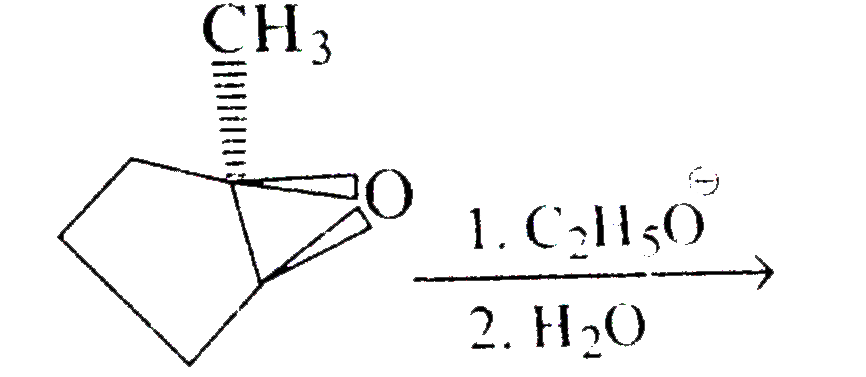
View SolutionAlthought epoxides do not contain a good leaving group, they contains a strained three membered ring with polar bonds. Nucleophilic attack opens the strained three membered ring making it favorable process even with the poor leaving group.

This reaction occurs readily with strong nucleophilic , and with acids like HZ, where Z is nucleophilic atom.


What would be the major product of reaction?
View SolutionAlthought epoxides do not contain a good leaving group, they contains a strained three membered ring with polar bonds. Nucleophilic attack opens the strained three membered ring making it favorable process even with the poor leaving group.

This reaction occurs readily with strong nucleophilic , and with acids like HZ, where Z is nucleophilic atom.


Find out major product of reaction:
View Solution1,2-diols are oxidised to ketones or aldehydes by periodic acid `HIO_(4)`. Periodic acid reacts with dipol to form a cyclic intermeditate. The reaction takes places because iodine is in a highly positive oxidation state, so it readily accepts electrons. When the intermeidate breaks down, the bond between the two carbon bonded to the OH group break.


Identify D.
View Solution1,2-diols are oxidised to ketones or aldehydes by periodic acid `HIO_(4)`. Periodic acid reacts with dipol to form a cyclic intermeditate. The reaction takes places because iodine is in a highly positive oxidation state, so it readily accepts electrons. When the intermeidate breaks down, the bond between the two carbon bonded to the OH group break.

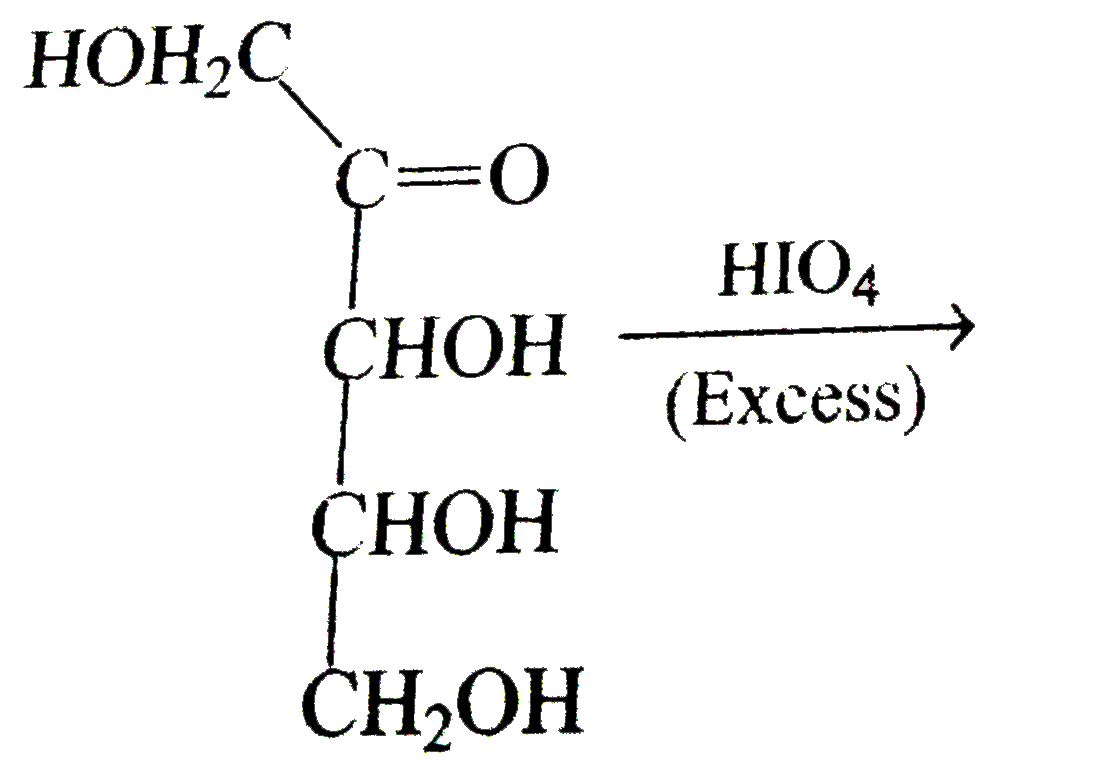
Which of the following will not form by above reaction?
View Solution1,2-diols are oxidised to ketones or aldehydes by periodic acid `HIO_(4)`. Periodic acid reacts with dipol to form a cyclic intermeditate. The reaction takes places because iodine is in a highly positive oxidation state, so it readily accepts electrons. When the intermeidate breaks down, the bond between the two carbon bonded to the OH group break.

Which of the following compounds will not react with `HIO_(4)`?
View SolutionCarbon oxygen double bond are easily reduced by `NaBH_(4) or LiAlH_(4)`. The actual reducing agent in these reduction is hrdride ion `(H^(-))`

The metal hydrogen bond in `LiAlH_(4)` is more than polar than metal hydrogen bond in `NaBH_(4)`. As a result `LiAlH_(4)` is strong reducing agent than `NaBH_(4)`. Esters, carboxylic acids, amides cannot be reduced by `NaBH_(4)`
The carbonyl group of amide of reduced to methylene group by `LiAlH_(4)`
Find the correct product of the following reaction:

View SolutionCarbon oxygen double bond are easily reduced by `NaBH_(4) or LiAlH_(4)`. The actual reducing agent in these reduction is hrdride ion `(H^(-))`

The metal hydrogen bond in `LiAlH_(4)` is more than polar than metal hydrogen bond in `NaBH_(4)`. As a result `LiAlH_(4)` is strong reducing agent than `NaBH_(4)`. Esters, carboxylic acids, amides cannot be reduced by `NaBH_(4)`
The carbonyl group of amide of reduced to methylene group by `LiAlH_(4)`
 , Identify X:
, Identify X:
View SolutionCarbon oxygen double bond are easily reduced by `NaBH_(4) or LiAlH_(4)`. The actual reducing agent in these reduction is hrdride ion `(H^(-))`

The metal hydrogen bond in `LiAlH_(4)` is more than polar than metal hydrogen bond in `NaBH_(4)`. As a result `LiAlH_(4)` is strong reducing agent than `NaBH_(4)`. Esters, carboxylic acids, amides cannot be reduced by `NaBH_(4)`
The carbonyl group of amide of reduced to methylene group by `LiAlH_(4)`

View SolutionAn organic compound (A) on treatment with `CHCl_(3) and KOH` gives (Y) and (Z) both of which in turn gives the same compound (T) when distilled with Zn. Oxidation of (T) Yields (S) of formula `C_(7)H_(6)O_(2)`. The sodium salt of (S) with sodalime gives (P) which can also be obtained by distilling (X).
The molecular weight of compound (X) is:
View SolutionAn organic compound (A) on treatment with `CHCl_(3) and KOH` gives (Y) and (Z) both of which in turn gives the same compound (T) when distilled with Zn. Oxidation of (T) Yields (S) of formula `C_(7)H_(6)O_(2)`. The sodium salt of (S) with sodalime gives (P) which can also be obtained by distilling (X).
The compound (T) is
View SolutionAn organic compound (A) on treatment with `CHCl_(3) and KOH` gives (Y) and (Z) both of which in turn gives the same compound (T) when distilled with Zn. Oxidation of (T) Yields (S) of formula `C_(7)H_(6)O_(2)`. The sodium salt of (S) with sodalime gives (P) which can also be obtained by distilling (X).
Compounds (Y) and (Z) could be:
View SolutionA tertiary alcohol (H) upon acid-catalysed dehydration gives a product (I). Ozonolysis of (I) leads to compounds (J) and (K). Compound (J) upon reaction with KOH gives benzyl alcohol and a compound (L), whereas (K) on reaction with KOH gives only (M).
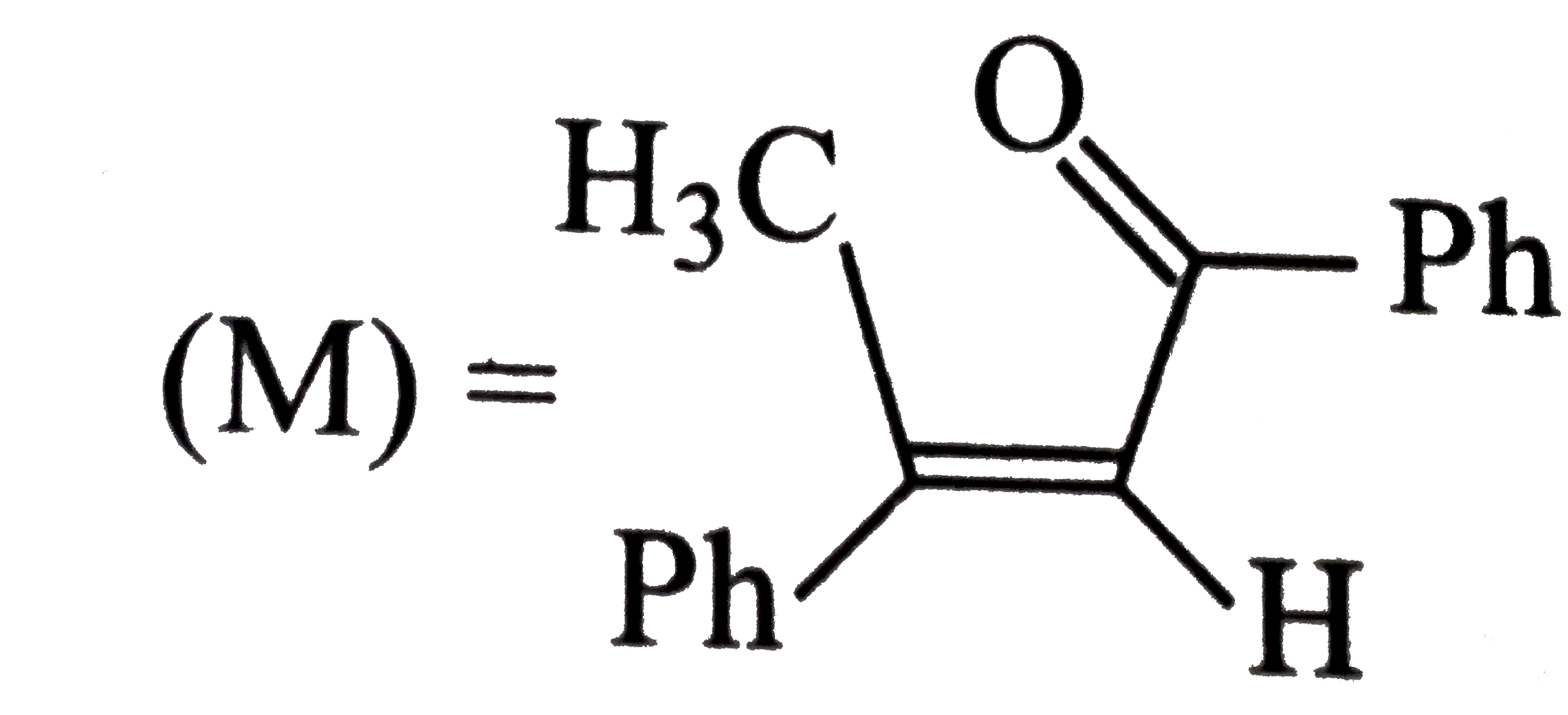
Compound (H) is formed by the reaction of:
View SolutionA tertiary alcohol (H) upon acid-catalysed dehydration gives a product (I). Ozonolysis of (I) leads to compounds (J) and (K). Compound (J) upon reaction with KOH gives benzyl alcohol and a compound (L), whereas (K) on reaction with KOH gives only (M).
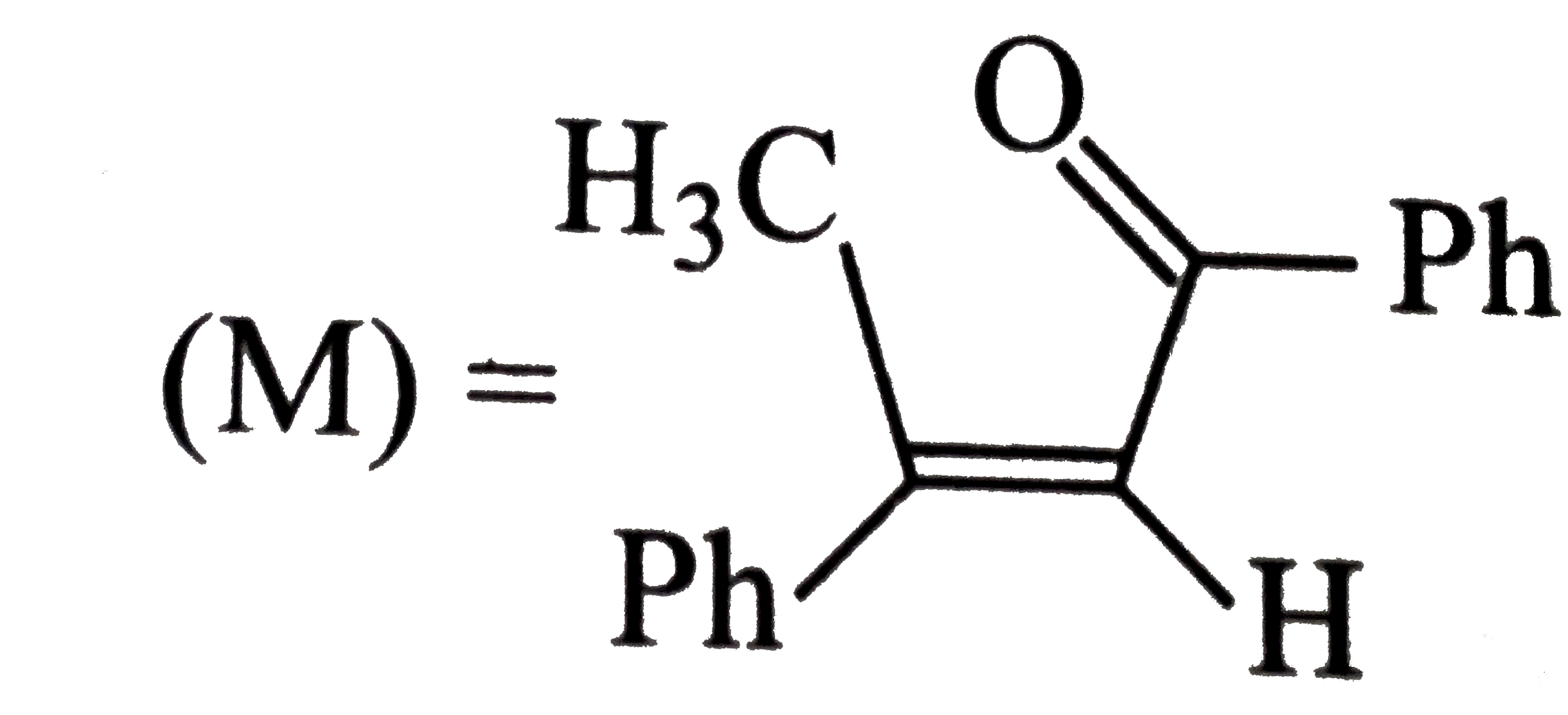
The structurer of compound (I) is:
View SolutionA tertiary alcohol (H) upon acid-catalysed dehydration gives a product (I). Ozonolysis of (I) leads to compounds (J) and (K). Compound (J) upon reaction with KOH gives benzyl alcohol and a compound (L), whereas (K) on reaction with KOH gives only (M).
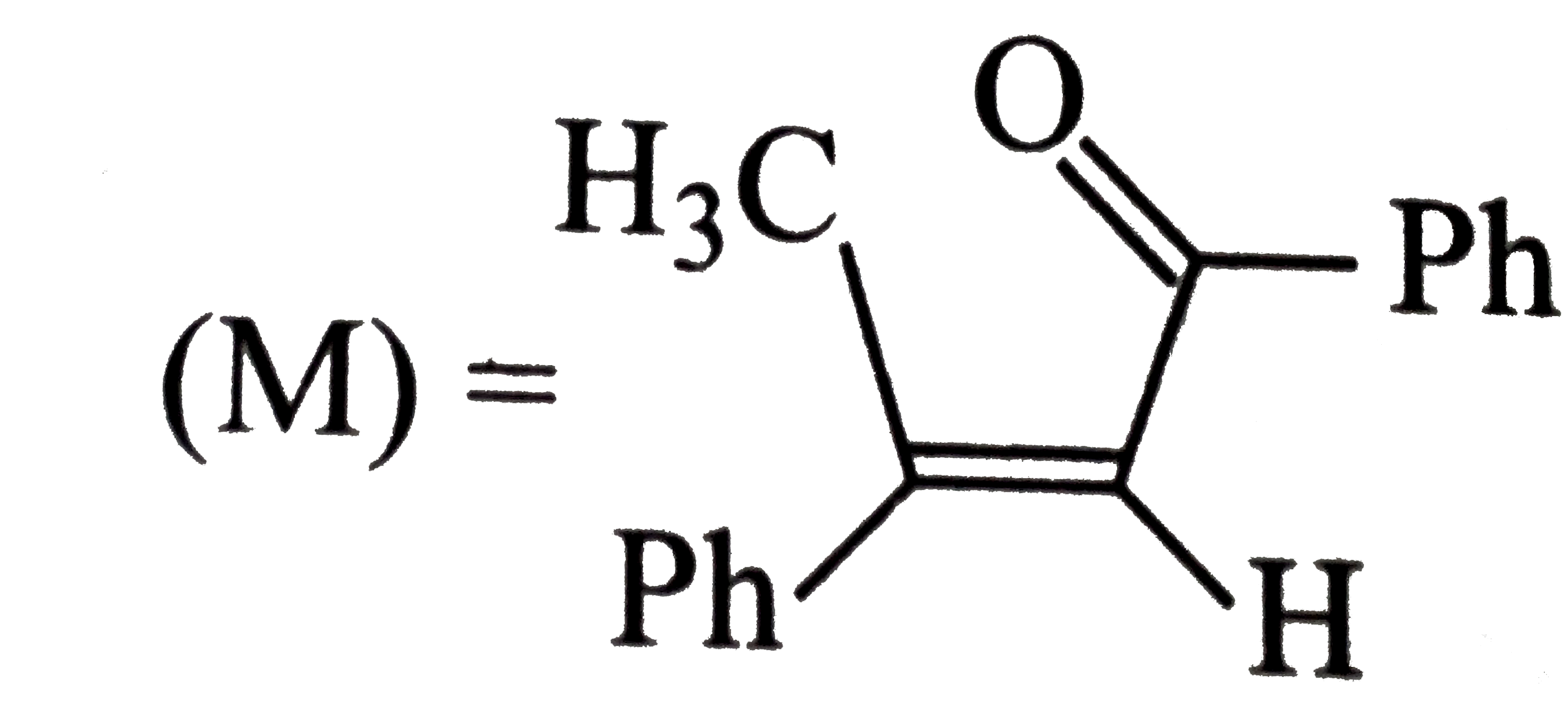
The structures of compounds (J), (K), and (L), respectively, are:
View SolutionAlcohols are converted to tosylates by treatment with p-toluence sulfonyl chloride (TsCl) in the presence of pyridine. This overall process converts a poor leaving group `(overset(Ө)H)` into good one `(overset(Ө)Ts)`. A tosylate is a good leaving group its conjugates acid p-touence sulfonic acid is strong acid. Beacuse alkyl tosylates have food leaving groups, they undergo both nucleophilic substitution and `beta-"elimination"`.
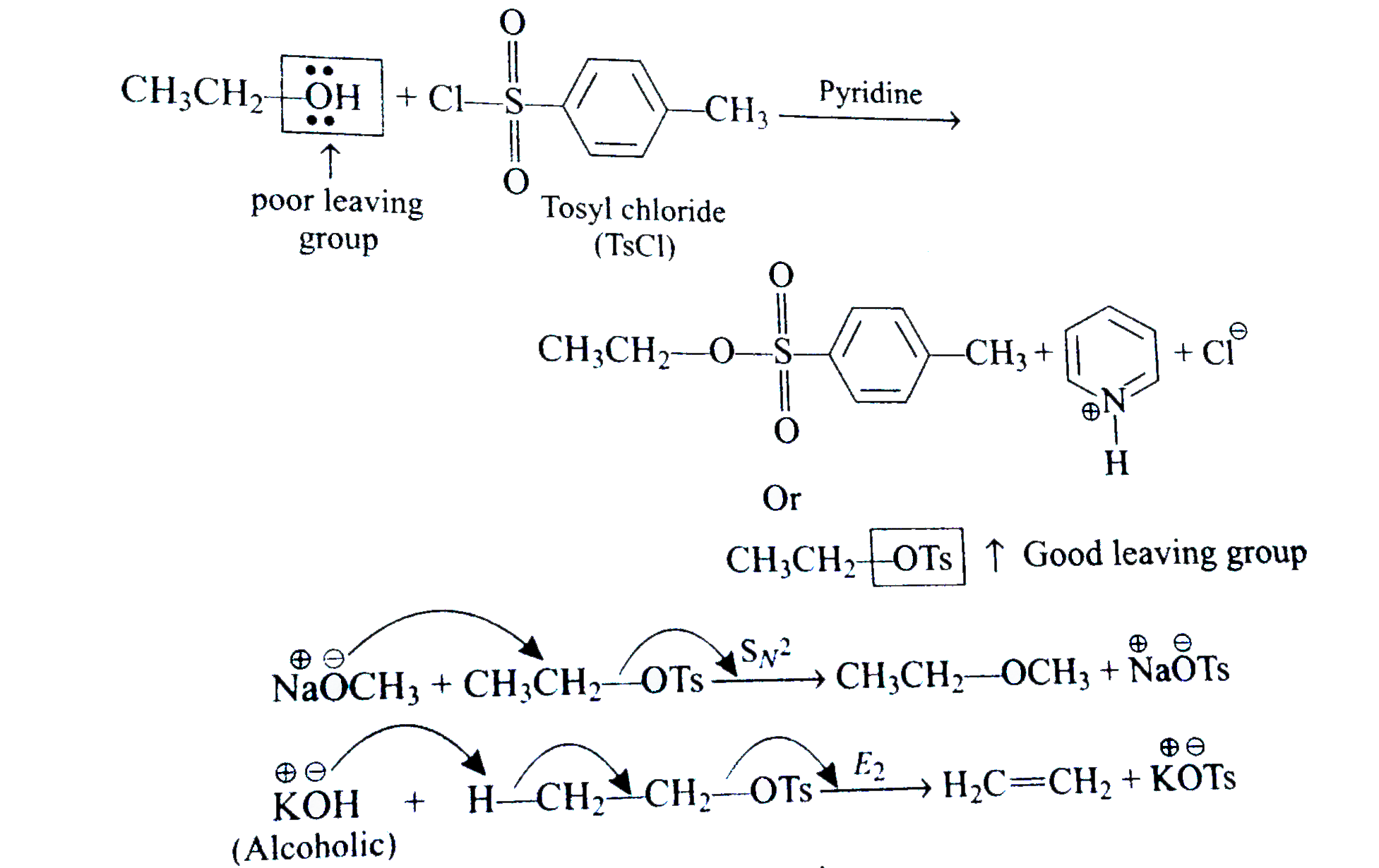
Find the major product of the following reaction:

View SolutionAlcohols are converted to tosylates by treatment with p-toluence sulfonyl chloride (TsCl) in the presence of pyridine. This overall process converts a poor leaving group `(overset(Ө)H)` into good one `(overset(Ө)Ts)`. A tosylate is a good leaving group its conjugates acid p-touence sulfonic acid is strong acid. Beacuse alkyl tosylates have food leaving groups, they undergo both nucleophilic substitution and `beta-"elimination"`.
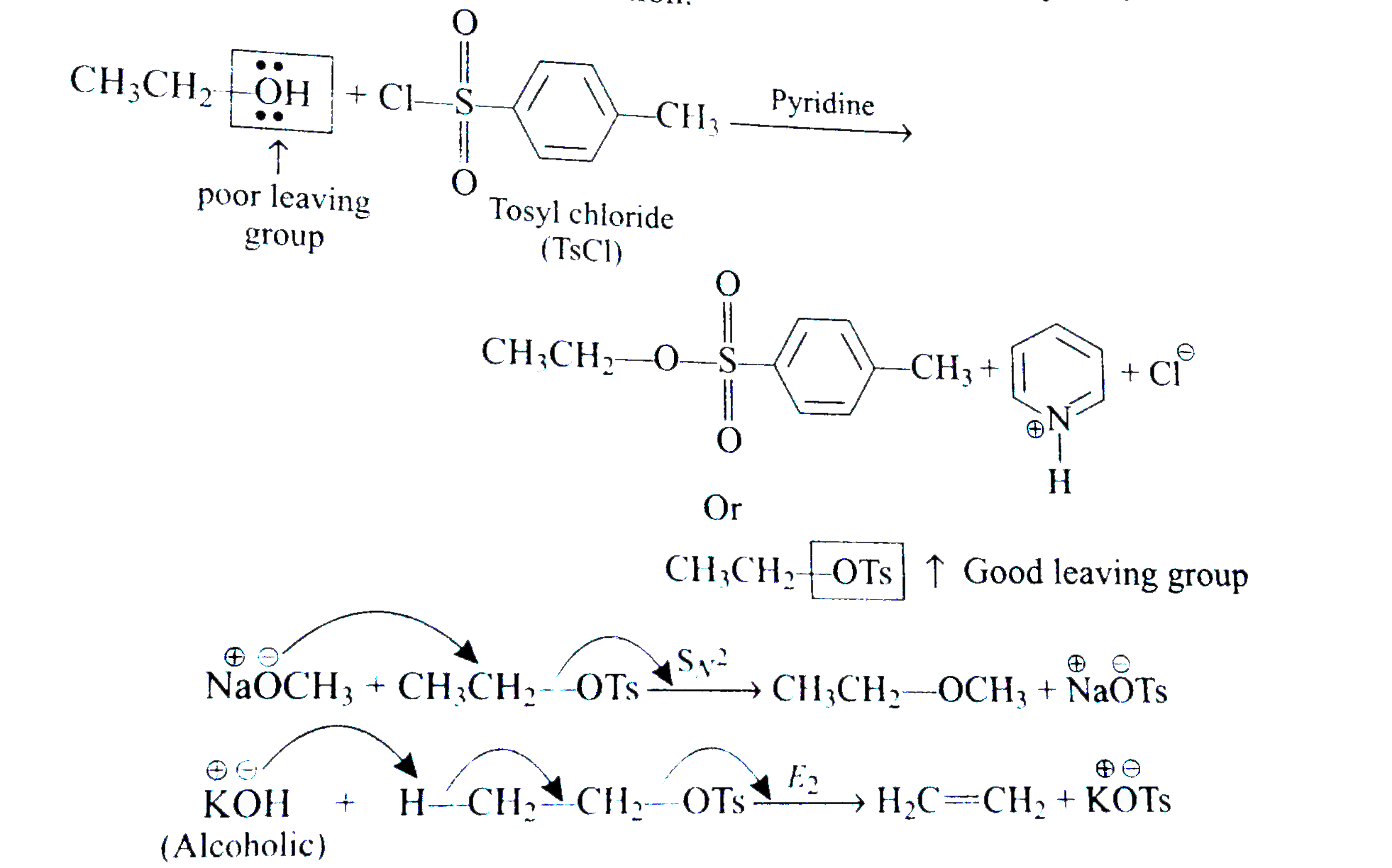
What would be the major product of the following reactions?

View SolutionAlcohols are converted to tosylates by treatment with p-toluence sulfonyl chloride (TsCl) in the presence of pyridine. This overall process converts a poor leaving group `(overset(Ө)H)` into good one `(overset(Ө)Ts)`. A tosylate is a good leaving group its conjugates acid p-touence sulfonic acid is strong acid. Beacuse alkyl tosylates have food leaving groups, they undergo both nucleophilic substitution and `beta-"elimination"`.
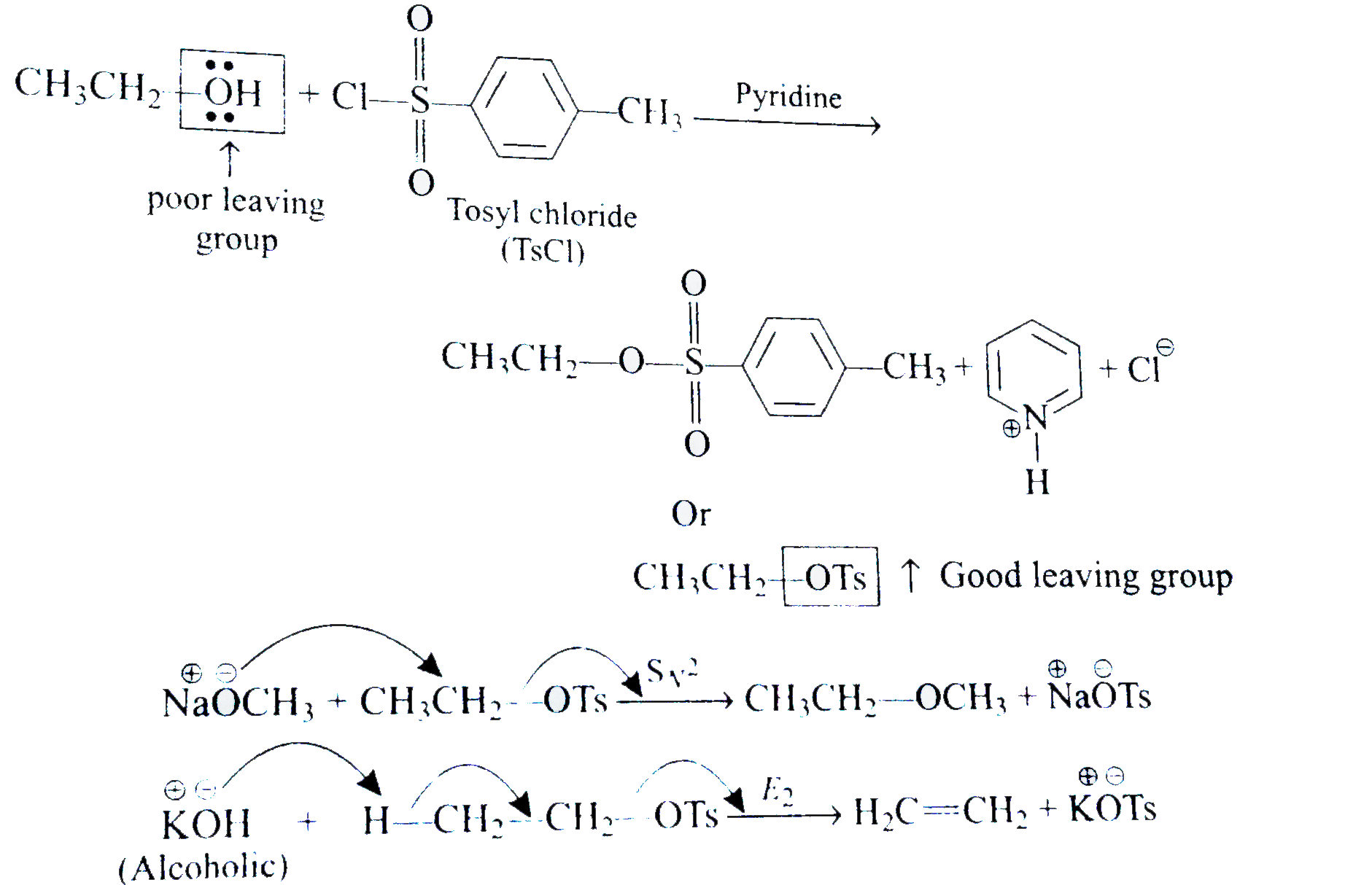
Idetify the final product of the following sequences of reactions:

View SolutionAcid catalysed conversation of 1,2-diol or vicinal, into carbonyl compound known as pinocaol-pinacolone rearrangement.
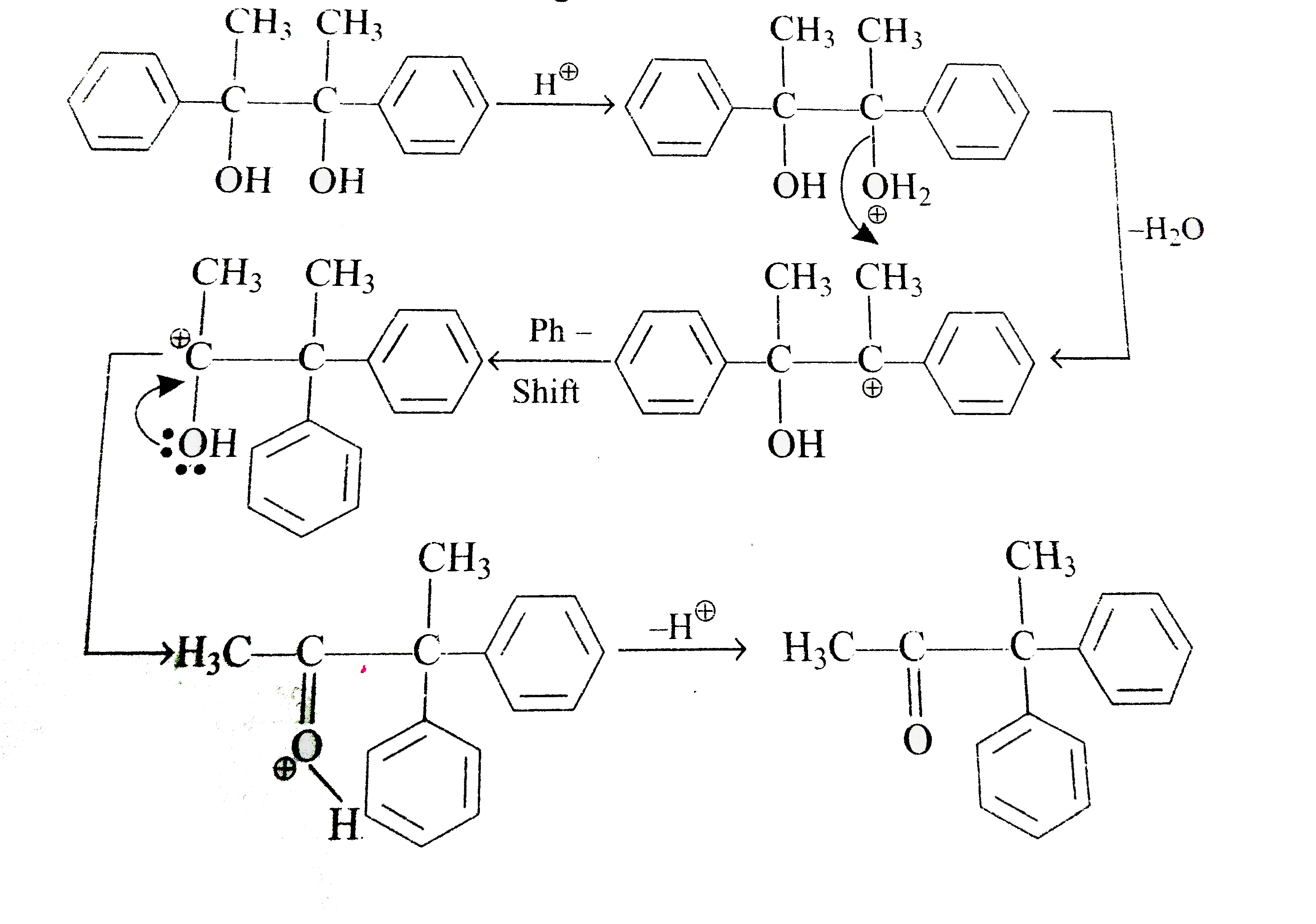
Generally more electron donating group migrate during mechanism, migration of H is faster because of its smaller size.
What would be the major product of reaction?

View SolutionAcid catalysed conversation of 1,2-diol or vicinal, into carbonyl compound known as pinocaol-pinacolone rearrangement.
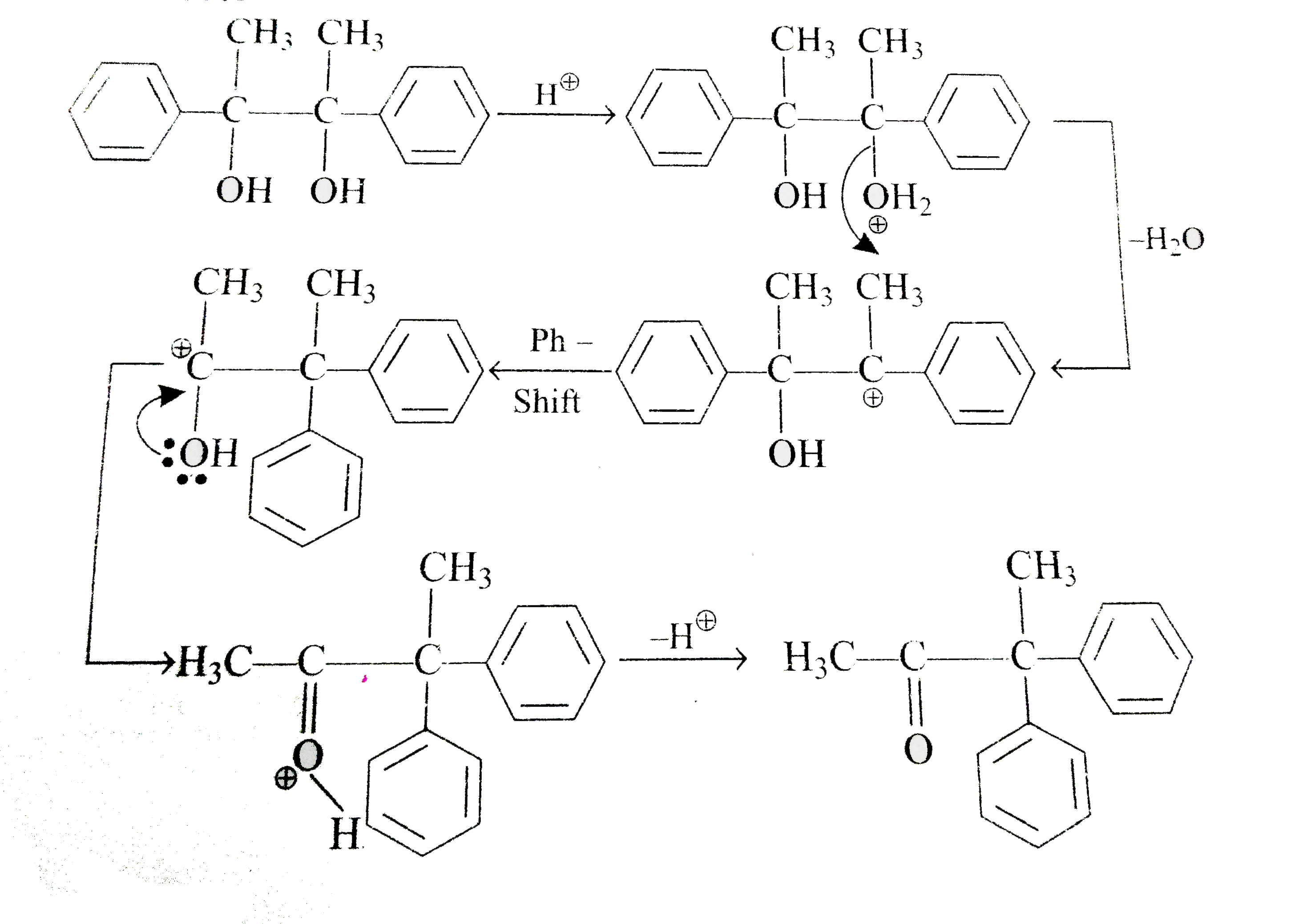
Generally more electron donating group migrate during mechanism, migration of H is faster because of its smaller size.

In this sequence of reaction final product is"
View SolutionAcid catalysed conversation of 1,2-diol or vicinal, into carbonyl compound known as pinocaol-pinacolone rearrangement.
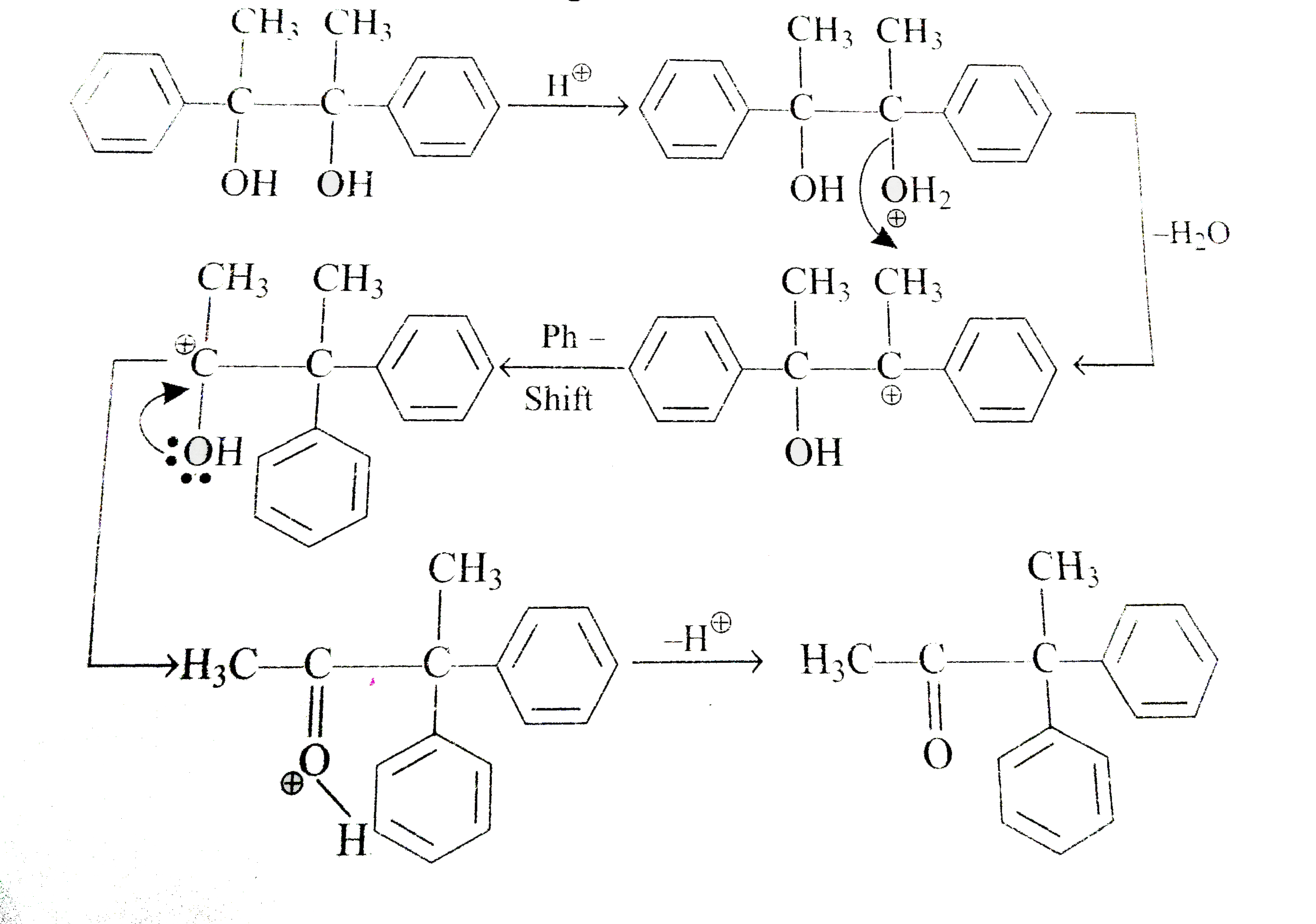
Generally more electron donating group migrate during mechanism, migration of H is faster because of its smaller size.
Which of the following is not correct about this rearrangement?
View SolutionCompound (A) `C_(10)H_(22)0_(2)` is insoluble in aq. NaOH bu not is `NaHCO_(3)`. Treatment of (A) with DMSO `(CH_(3)-overset(S)overset(||)(S)-CH_(3))` in alkali give (B) `C_(11)H_(14)O_(2)`. Treatment of (A) with strong alkali alone give an isomeric compound (C). When (A) is reflux with HI, `CH_(3)I` is obtained, compound (B) is insoluble in alkali and decolurises `Br_(2)//C Cl_(4)`. (B) on treating with strong base gives (D), an isomer of (B). Ozonolysis (C) of gives (E), `C_(8)H_(8)O` and isomer of vanilline. Ozolysis of (D) gives (F) `C_(9)H_(10)O_(3)`, which is identical with product of methylation of vanilline (4-hydroxy-3-methoxy benzaldehyde).
Structure of compound (A) is:
View SolutionCompound (A) `C_(10)H_(22)0_(2)` is insoluble in aq. NaOH bu not is `NaHCO_(3)`. Treatment of (A) with DMSO `(CH_(3)-overset(S)overset(||)(S)-CH_(3))` in alkali give (B) `C_(11)H_(14)O_(2)`. Treatment of (A) with strong alkali alone give an isomeric compound (C). When (A) is reflux with HI, `CH_(3)I` is obtained, compound (B) is insoluble in alkali and decolurises `Br_(2)//C Cl_(4)`. (B) on treating with strong base gives (D), an isomer of (B). Ozonolysis (C) of gives (E), `C_(8)H_(8)O` and isomer of vanilline. Ozolysis of (D) gives (F) `C_(9)H_(10)O_(3)`, which is identical with product of methylation of vanilline (4-hydroxy-3-methoxy benzaldehyde).
Compound (B) is:
View SolutionCompound (A) `C_(10)H_(22)0_(2)` is insoluble in aq. NaOH bu not is `NaHCO_(3)`. Treatment of (A) with DMSO `(CH_(3)-overset(S)overset(||)(S)-CH_(3))` in alkali give (B) `C_(11)H_(14)O_(2)`. Treatment of (A) with strong alkali alone give an isomeric compound (C). When (A) is reflux with HI, `CH_(3)I` is obtained, compound (B) is insoluble in alkali and decolurises `Br_(2)//C Cl_(4)`. (B) on treating with strong base gives (D), an isomer of (B). Ozonolysis (C) of gives (E), `C_(8)H_(8)O` and isomer of vanilline. Ozolysis of (D) gives (F) `C_(9)H_(10)O_(3)`, which is identical with product of methylation of vanilline (4-hydroxy-3-methoxy benzaldehyde).
Compound (E) and (F) are respectively:
View Solution
Linked Comprehension Type questions and complete solutions for chapter ALCOHOLS AND ETHERS of GR BATHLA & SONS CHEMISTRY (HINGLISH) of Class 12
All Exercises from HIMANSHU PANDEY Class 12 CHEMISTRY ALCOHOLS AND ETHERS
- Integer Answer Type Problems
- Level 1 (Q.1 To Q.25)
- Level 1 (Q.26 To Q.50)
- Level 2 (Q.1 To Q.25)
- Level 2 (Q.101 To Q.125)
- Level 2 (Q.126 To Q.132)
- Level 2 (Q.26 To Q.50)
- Level 2 (Q.51 To Q.75)
- Level 2 (Q.76 To Q.100)
- Linked Comprehension Type
- Match The Column
- More Than One Correct (Q.1 To Q.25)
- More Than One Correct (Q.26 To Q.50)
- Subjective Type Problems